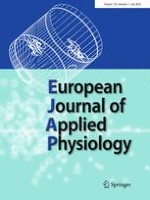Published in:

01-07-2018 | Original Article
Aerobic fitness alters the capacity of mononuclear cells to produce pentraxin 3 following maximal exercise
Authors:
Aaron L. Slusher, Tiffany M. Zúñiga, Edmund O. Acevedo
Published in:
European Journal of Applied Physiology
|
Issue 7/2018
Login to get access
Abstract
Purpose
Pentraxin 3 (PTX3) is a vital regulator of innate immune function. Although plasma PTX3 concentrations are elevated with aerobic fitness, the cellular functions of PTX3 remain unknown in aerobically trained and untrained subjects.
Methods
Thirty individuals (aerobically trained = 15 and untrained = 15) participated in a maximal exercise protocol to examine ex vivo PTX3 production from isolated peripheral blood mononuclear cells (PBMCs) exposed to LPS or palmitate. The capacity of PTX3 to stimulate inflammatory cytokine production ex vivo was also examined.
Results
Elevated plasma PTX3 concentrations prior to exercise were positively associated with the percent change (pre to post exercise) in plasma PTX3 concentrations in all subjects, independent of cardiorespiratory fitness (VO2max). In addition, elevated plasma PTX3 concentrations in aerobically trained subjects at rest predicted changes in the LPS- and palmitate-stimulated PTX3 production from isolated PBMCs following acute exercise. In response to PTX3 simulation, the capacity of PBMCs to produce the anti-inflammatory cytokine IL-10 was decreased following acute exercise in all subject (no changes in IL-6, TGF-β1, and TNF-α observed). However, the percent change in IL-6 production was positively associated with VO2max in all subjects, and in aerobically trained subjects only, positively associated with elevated plasma PTX3 concentrations at rest and in response to acute exercise.
Conclusion
These results suggest that aerobic training enhances the utilization of plasma PTX3 concentrations to predict the capacity of mononuclear cells to produce PTX3, and potentially, its reciprocal role of PTX3 as an initiator of the innate immune response following maximal exercise.